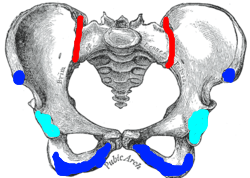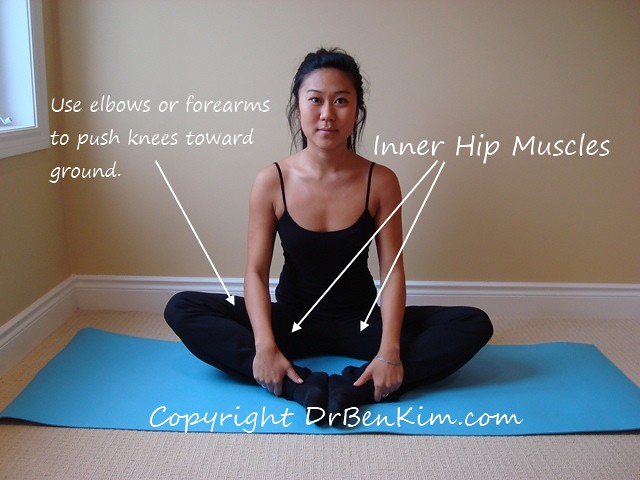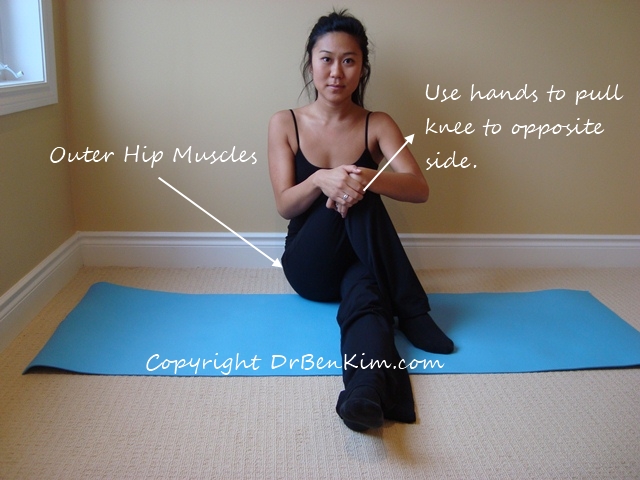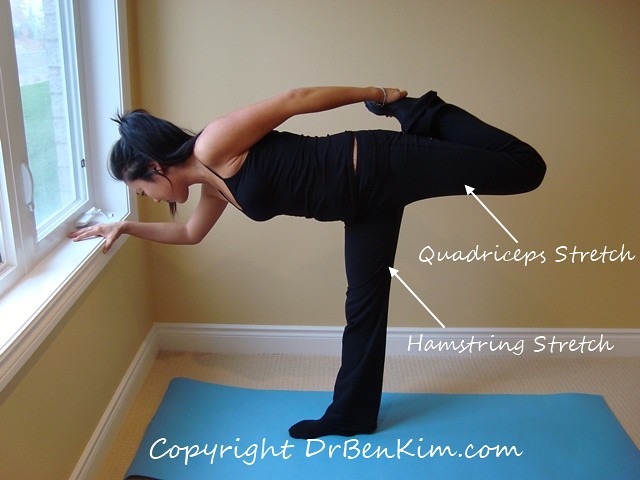You are here
Four Stretches to Support Your Pelvic Region
 If you embrace the adage about an ounce of prevention being worth a pound of cure, you'll want to review the following information about your pelvic region, including four simple stretches that, if performed daily, may spare you many of the strains, sprains, and aches that are often attributed to aging.
If you embrace the adage about an ounce of prevention being worth a pound of cure, you'll want to review the following information about your pelvic region, including four simple stretches that, if performed daily, may spare you many of the strains, sprains, and aches that are often attributed to aging.
 To the right is a picture of the bones that make up your pelvic girdle.
To the right is a picture of the bones that make up your pelvic girdle.
The red lines mark the attachment sites of your pelvic bones to your sacrum, which is the functional base of your spine. Located within these red lines are your upper and lower sacroiliac joints; the ligaments that stabilize these joints are commonly sprained with lower back injuries.
The royal blue areas represent attachment areas for many of the powerful muscles that surround your hip joints. These muscles help stabilize your hip joints, but most importantly, they allow you to move your hips through a wide range of motion.
The light aqua blue areas are the sockets that the upper balls of your thigh bones insert into to create your "ball and socket" hip joints. These joints are surrounded by a series of dense ligaments that are intended to prevent dislocation of your hip joints.
Your pelvis bears a ton of workload because it serves as a fulcrum between your lower and upper halves. Given its location and function, your pelvis needs to be both stable and flexible.
For optimal hip, pelvic, and lower back health, it's vital that you regularly stretch the muscles and ligaments that surround your pelvis. Lack of use and controlled stretching inevitably leads to tightening and even shortening of skeletal muscles, which can create imbalances that predispose you to injury.
For example, if your hamstrings are chronically tight, they will create a constant downward pull on your pelvis because they attach to the very bottom portions of your pelvic bones. This downward pull, however slight, can put unnecessary stress on your sacroiliac joints (red lines in picture above), which can predispose the ligaments surrounding these joints to being overextended and sprained during activity.
This same principle holds true with the rest of the muscles that come up from your thighs to attach to a part of your pelvis - if your quadriceps, outer hip muscles, or inner hip muscles are tight or shortened from lack of use and stretching, you are almost certainly at increased risk of injuring other ligaments and muscles in your pelvis and lower back.
What follows are four simple stretches that you can use to keep all of the major muscle groups that surround your pelvis flexible and perfused with healthy blood circulation.
Stretch for Inner Hip Muscles
Sit with your back upright and bend your legs to have the soles of your feet touch each other. Let your knees fall outward towards the ground, hold your feet or ankles with your hands, then use your forearms or elbows to provide a gentle downward push on your upper thighs to get your knees closer to the ground which should facilitate a stretch of your inner hip muscles. Once you feel a stretch in your inner groin area, hold for up to 30 seconds or however long is comfortable, then release.
If you have limited range of motion in your hips and can't get into this position, try lying on a comfortable surface, touching the soles of your feet together, then letting your knees fall outward as far as is comfortable. Even if your knees don't come close to touching the ground or surface you're lying on, as long as you feel a stretch in your inner hip region, you'll experience some benefit.
Stretch for Outer Hip Muscles
Sit with your legs outstretched on the ground in front of you. To stretch the outer hip muscles of your right leg, cross your right leg over your left leg and put the sole of your right foot on the ground beside your left leg.
Use your hands or elbows to pull your right knee back towards your left armpit until you feel a stretch along the outside of your right hip. Hold for as long as is comfortable, then release.
Stretch for Hamstrings
To stretch the hamstrings of your right leg, sit in a "hurdler's position" with your right leg straight and flattened on the ground in front of you, and your left leg bent behind you.
The key to doing this stretch without hurting your lower back is to keep your trunk straight and strong, then to bend forward from the waist. You don't want to aim to bring your head down towards your knee as much as you want to aim your entire upper body forward towards the space above your right foot.
If you keep your trunk straight and strong while bending forward from the waist, even a slight forward bend should produce a good stretch in your hamstrings, which you may feel anywhere along the back of your thigh, even at the back of your knee.
When you feel a good stretch, hold, then release.
If you need help bending forward, try wrapping a long towel around the sole of your right foot and use your hands to gently pull on the ends of the towel to help bring your upper body forward.
Stretch for Quadriceps and Hamstrings
To stretch your left quadriceps and right hamstrings, while standing, bend your left knee back as far as it will go, use your left hand to pull your left ankle flush against your left buttock or left hamstring, then bend forward at the waist until your left quadriceps and upper body are parallel to the ground. Try to keep your right leg straight and steady on the ground, and if necessary, keep your balance by steadying your upper body with your right arm against a nearby surface.
This position should create a stretch in your left quadriceps and your right hamstrings. If you feel stretches in these areas before your body becomes parallel with the floor, this is fine - just bend down as far as you comfortably can until you feel a stretch. If you can't bend down far enough to feel a stretch in your right hamstrings, just focus on creating a stretch in your left quadriceps.
Safe Stretching Principles
For all of the stretches above, please keep the following principles in mind for safe and effective stretching:
-
Try to stretch later in the afternoon or evening, when your blood circulation is at its peak. Blood circulation is at its worst first thing in the morning, a consequence of your heart not having to work very hard in the absence of significant gravitational force while you are sleeping in a horizontal position. As you go about your daily activities, your blood circulation naturally improves as your heart begins working harder.
-
If possible, save intense stretching sessions, like a yoga class, for after you have done a good warm up. The more you exercise or warm up before you stretch, the more blood flow your muscles will have, which decreases their risk of suffering a strain or tear.
-
Do not bounce with your stretches. Move your body slowly and gradually into a position that allows you to feel a solid stretch in the target muscle, then hold this position and focus on keeping your breathing steady.
-
Never stop breathing while you stretch. If you find yourself holding your breath on a regular basis during stretching sessions, consider this a sign that you are putting too much stress on your tissues. and ease back on the intensity of your stretches.
-
Where applicable, be sure to stretch both sides of your body to promote good overall symmetry.
My experience has been that the benefits of stretching can be enhanced by foam rolling the target areas before or after stretching sessions. For pictorials on how to foam roll most of the areas discussed in this post, feel free to review the pages listed in the "Related Posts" box below.
I realize that most people are aware of the stretches shown in this post. If for nothing else, may this post be a reminder to actually do these stretches daily. Good physical health, like all other things in life that have lasting value, is gradually attained or lost according to our daily habits. Making time to stretch every day - even for a few minutes while we're watching a movie or television program - is well worth the effort.
If you don't have a foam roller and are looking to invest in one that offers a blend of comfort, durability, and ideal density to provide therapeutic rolling of your muscles and ligaments, please feel free to have a look at the one that I had custom made for our clients here:
For a DVD that presents still photos and video clips that illustrate how to take your body through all of the major stretches and foam rolling exercises you can do to keep your body as healthy as your genetics will allow, have a look here:
Stretching and Foam Rolling DVD, by Sharon Lee and Dr. Ben Kim
Join more than 80,000 readers worldwide who receive Dr. Ben Kim's free newsletter
Receive simple suggestions to measurably improve your health and mobility, plus alerts on specials and giveaways at our catalogue
Please Rate This
Highest RatedNo articles have been rated for usefulness recently, please check later. | Related Posts | ||















Comments
Four Stretches to Support Your Pelvic Region
Wow, this information just told me I have been right all along! I mean, I have been doing these exercises many times over (though not regularly) because they felt "good", but you saved me the explanations of the benefits i get through them! Thanks again. Now, I know I must do it regularly. Hey, any exercise recommended for stuffy/runny nose or even for the immediate relief of asthma? I have a couple of exercises recommended for the the former. Still figuring out for the latter. Regards and thanks again.